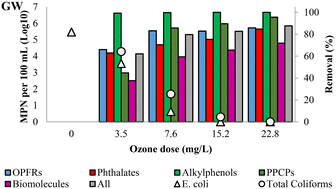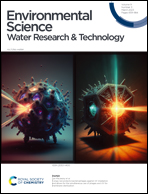GC-HRMS analysis to evaluate the effectiveness of ozone disinfection in the removal of micropollutants from wastewater†
Abstract
The objective of this study was to apply targeted and untargeted screening analyses to perform a deep assessment of micropollutant removal during wastewater disinfection by ozonation. To perform this study, effluents from two wastewater treatment plants (WWTPs) were treated with ozone at different doses and analyzed using gas chromatography coupled with Orbitrap High-Resolution Mass Spectrometry. The removal of different chemical families was assessed in relation to the level of Escherichia coli and the total removal of coliforms. The micropollutant removal rates at the typical ozone dose for disinfection (7.6 mg O3 per L) followed the order alkylphenols > pharmaceuticals and personal care products > organophosphorus flame retardants > phthalates > biomolecules. Micropollutant removal during ozone disinfection depended on their initial concentration and the physiochemical characteristics of the secondary effluent. Although bacterial inactivation in mixed gray water (GW) was observed at a dose of 15.2 mg O3 per L, most contaminants were recalcitrant to degradation by ozone and were present in the treated effluent at concentrations ranging from 10 to 1450 ng L−1; however, these effluents were not toxic to Daphnia magna. The methodology proposed in this study is intended to provide a new protocol for the careful evaluation of ozonized WWTP effluents for disposal and reuse.



 Please wait while we load your content...
Please wait while we load your content...